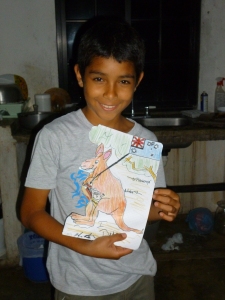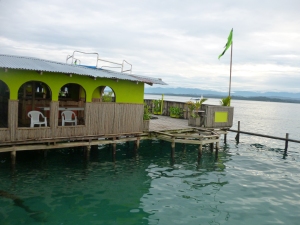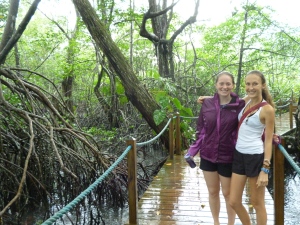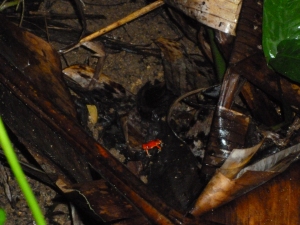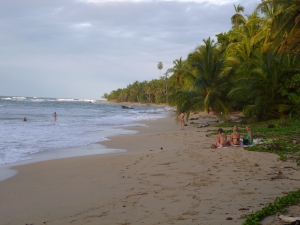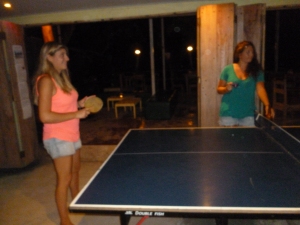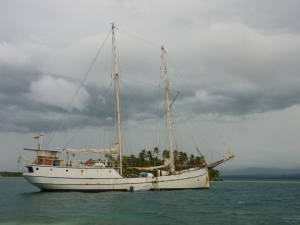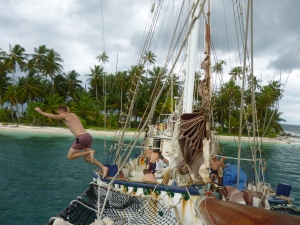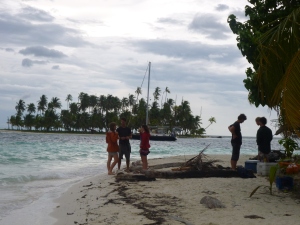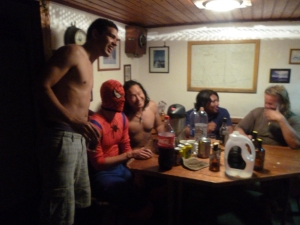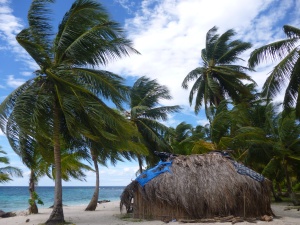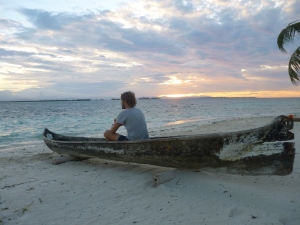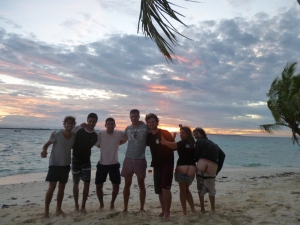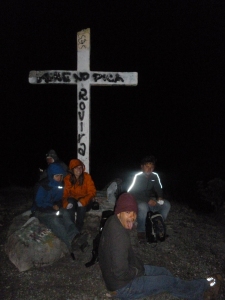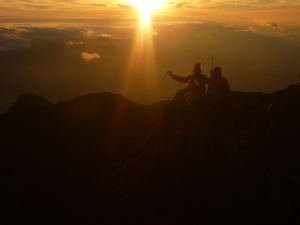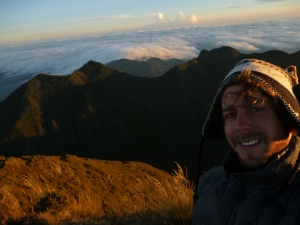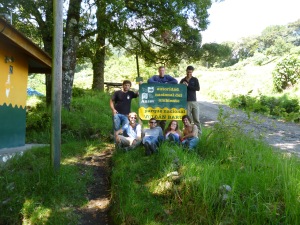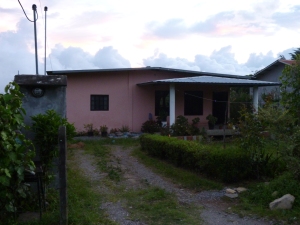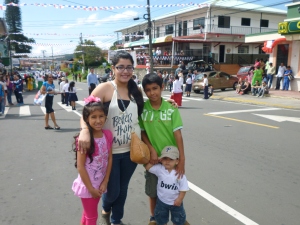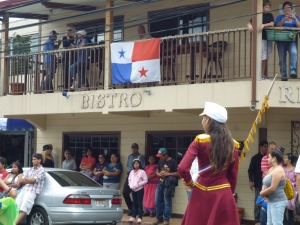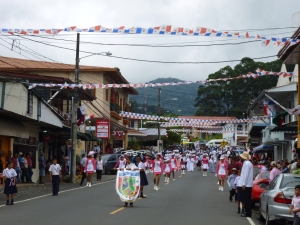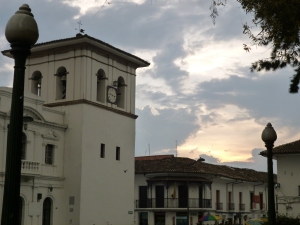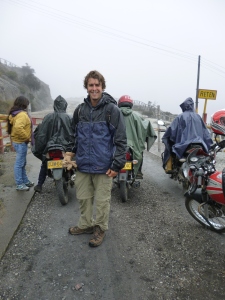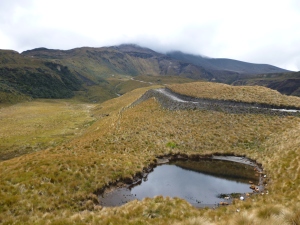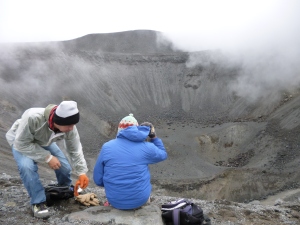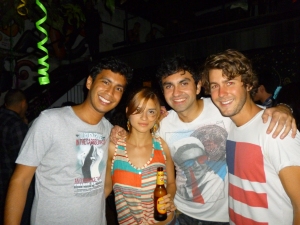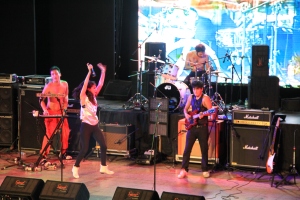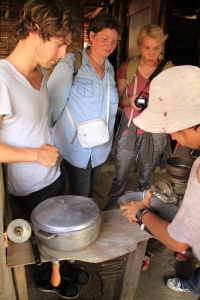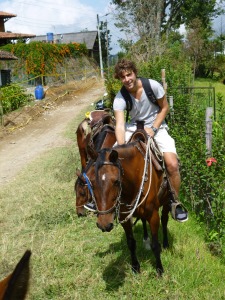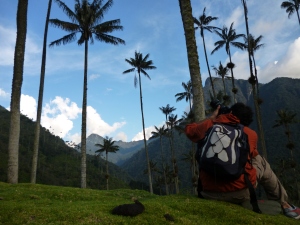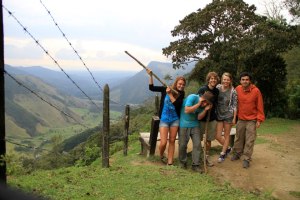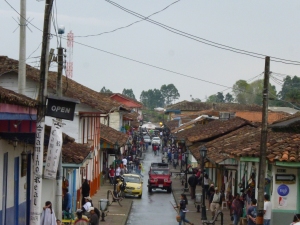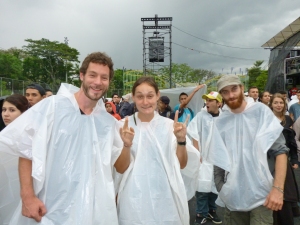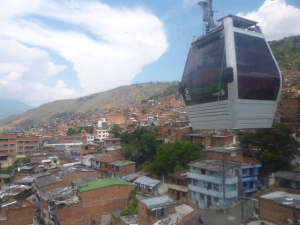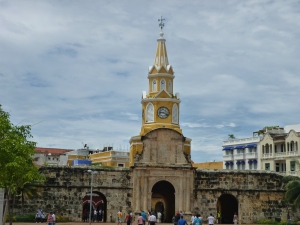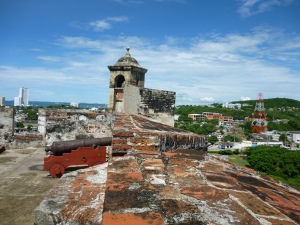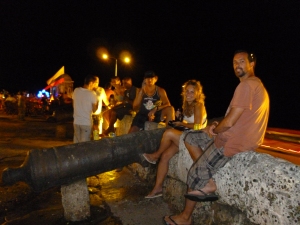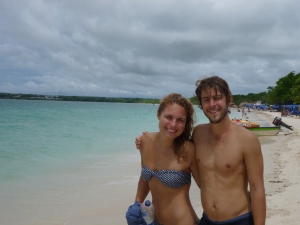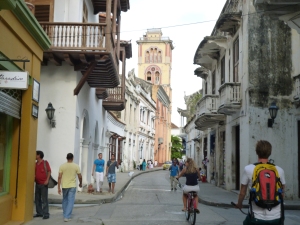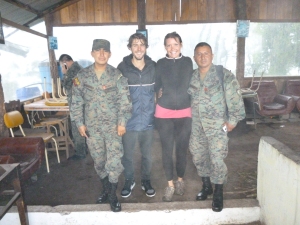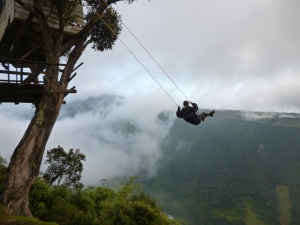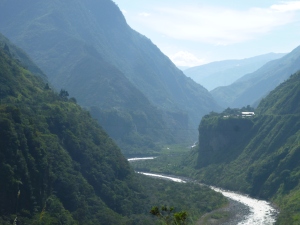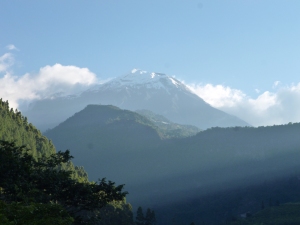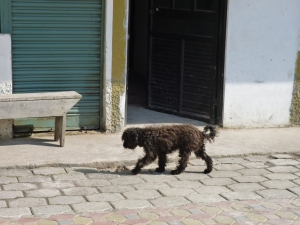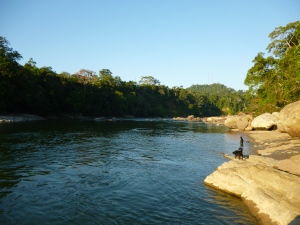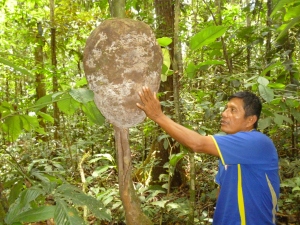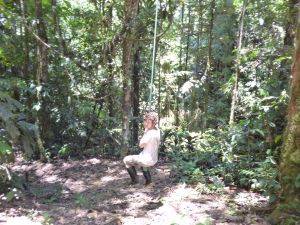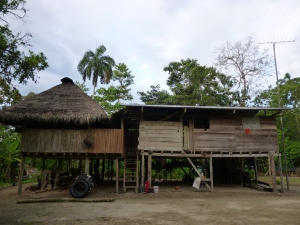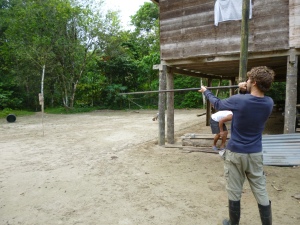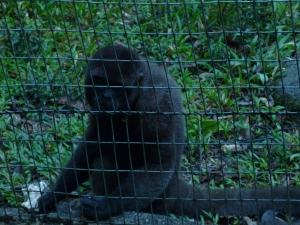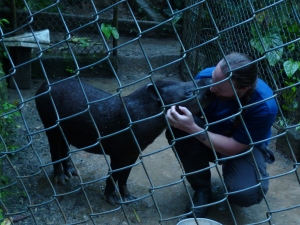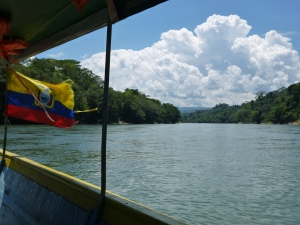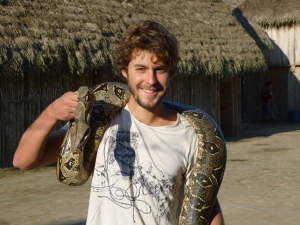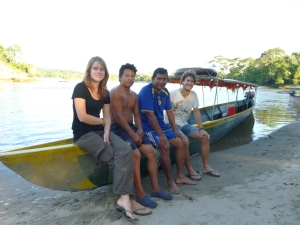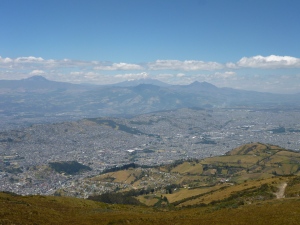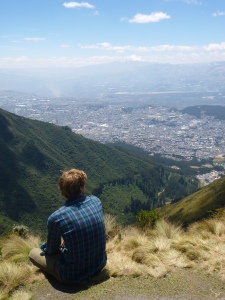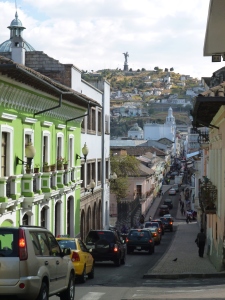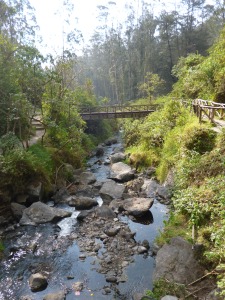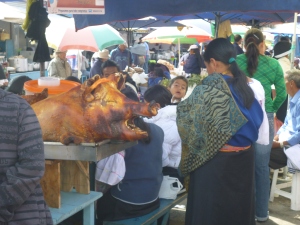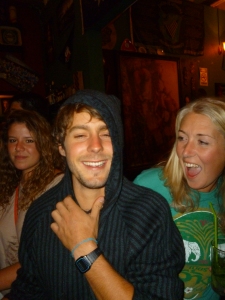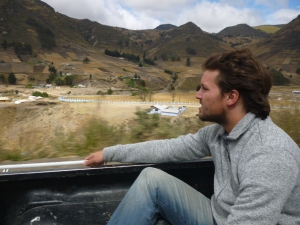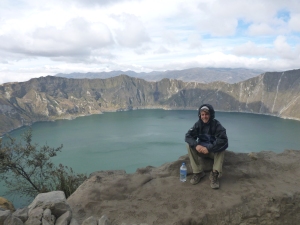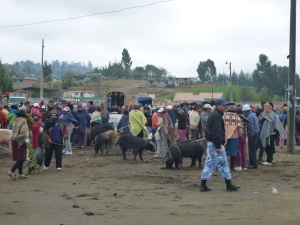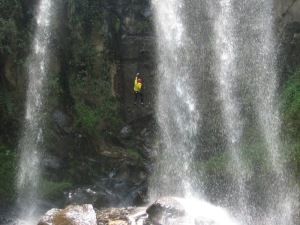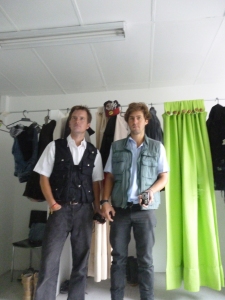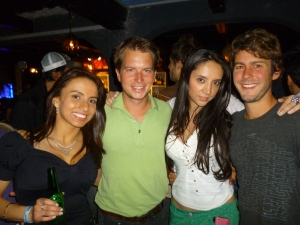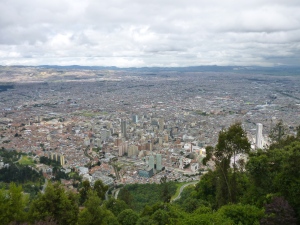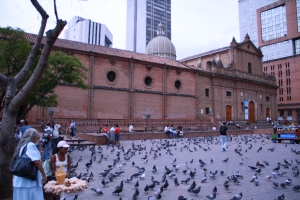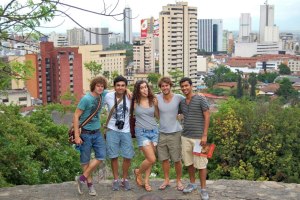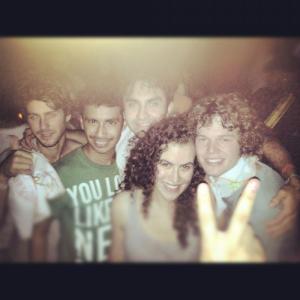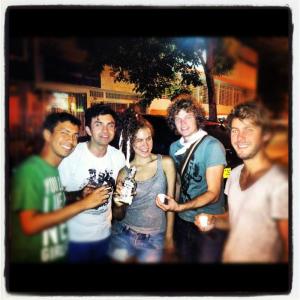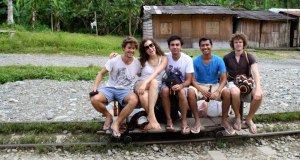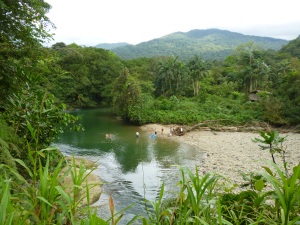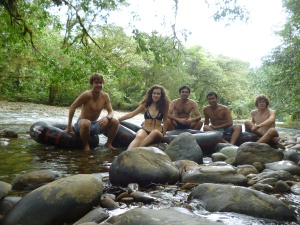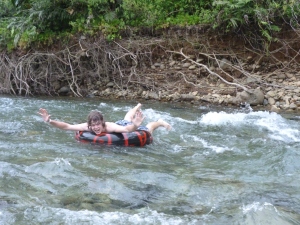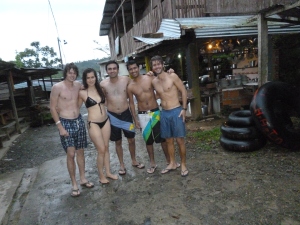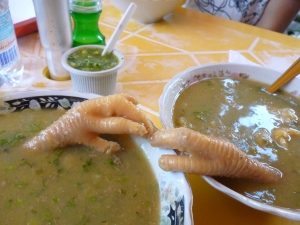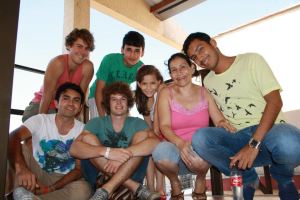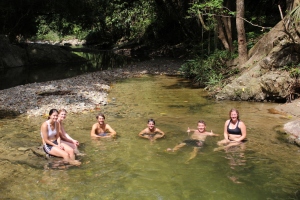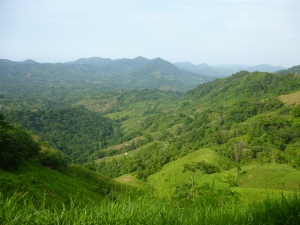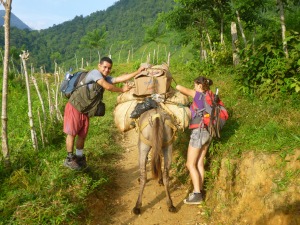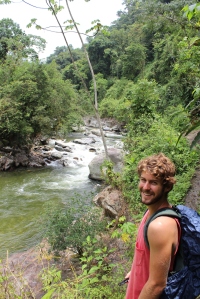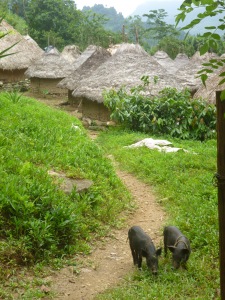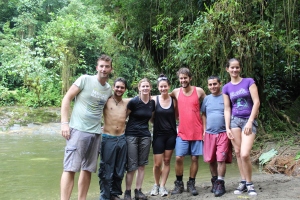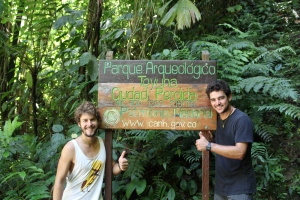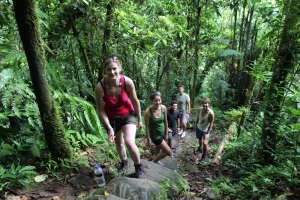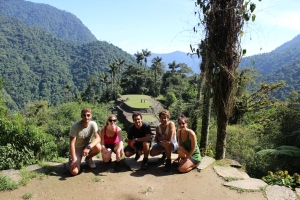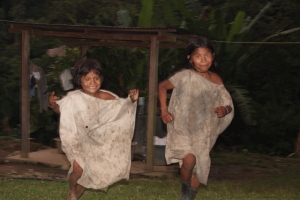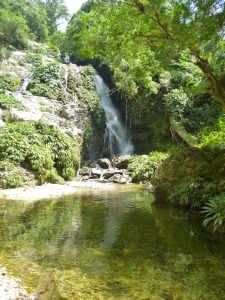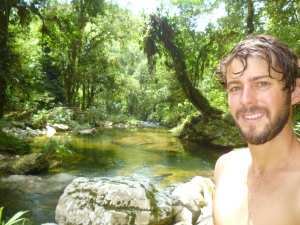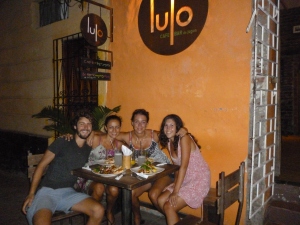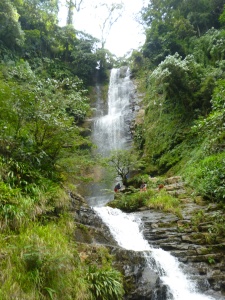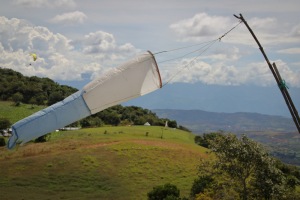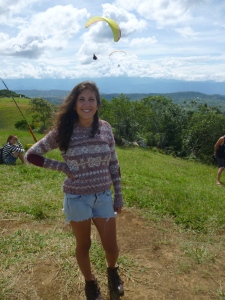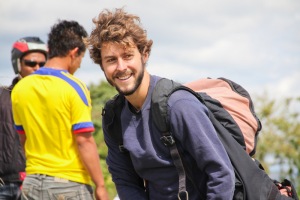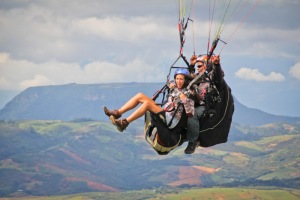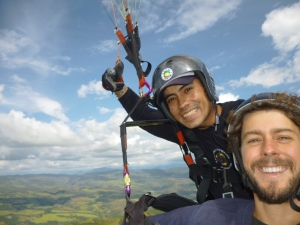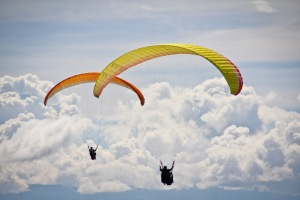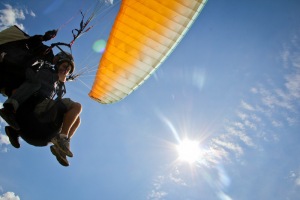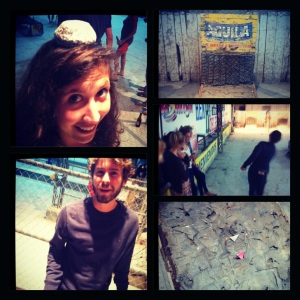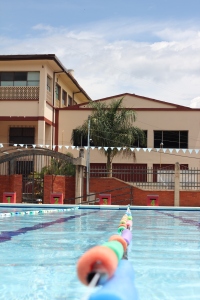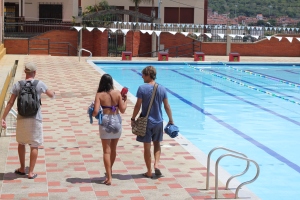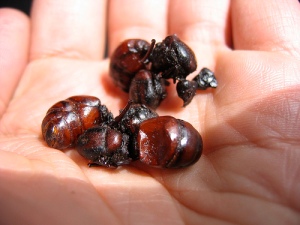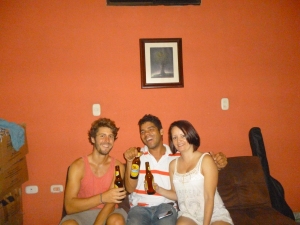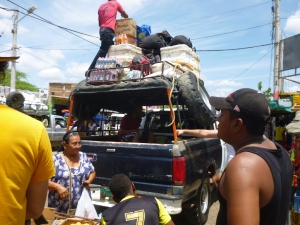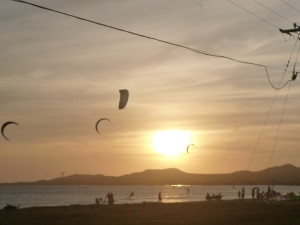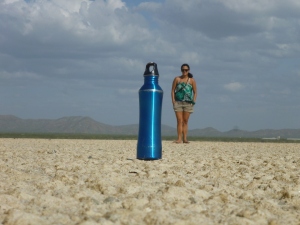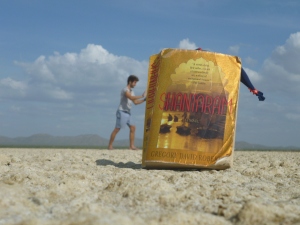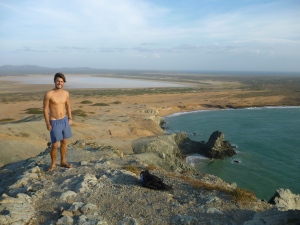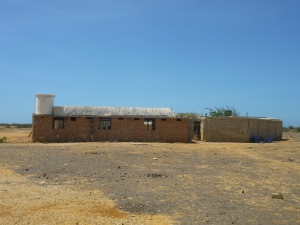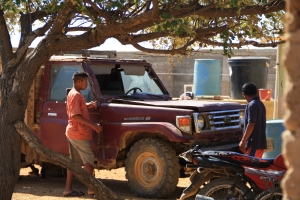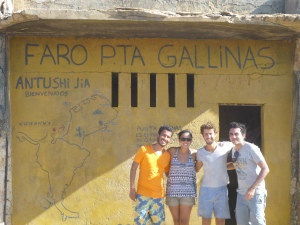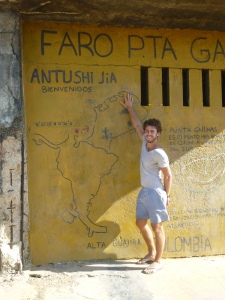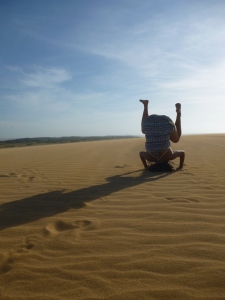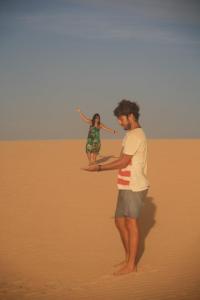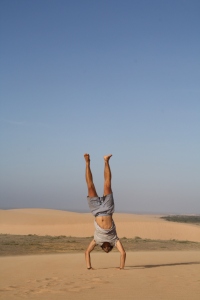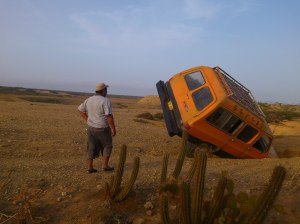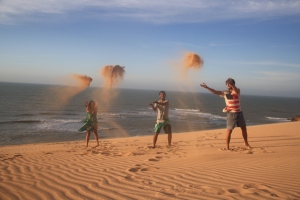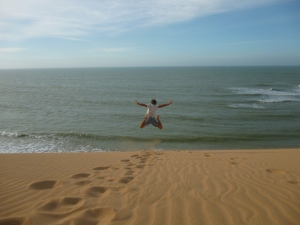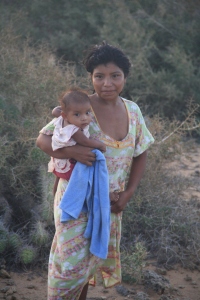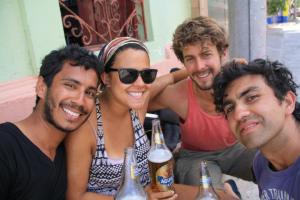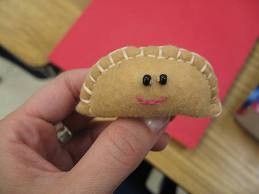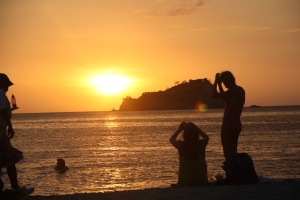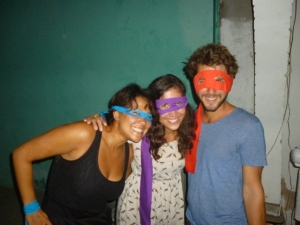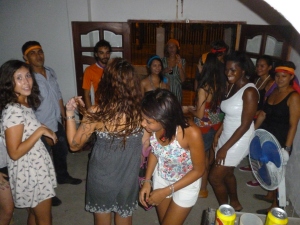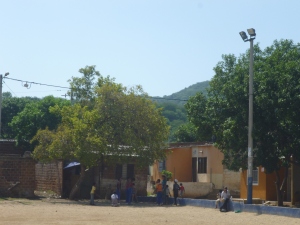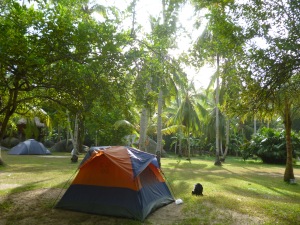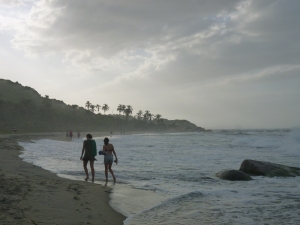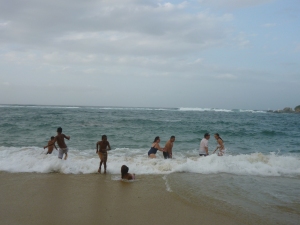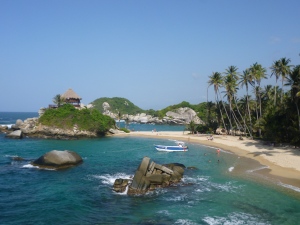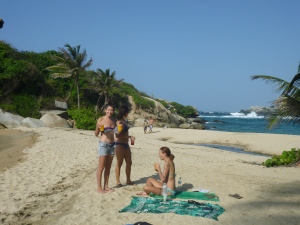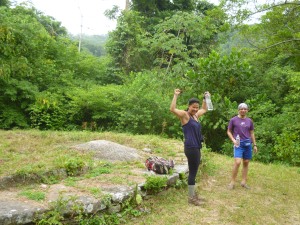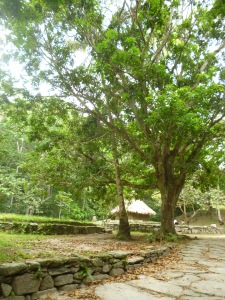Back to English. Polly and I left our jungle lodge in Masahualli and headed for a popular town in the south of Ecuador called Cuenca. Cuenca is known to be one of the wealthiest cities in Ecuador and accordingly has plenty of cafes, bars and restaurants. On the way to Cuenca we met Morgan and Britney, two Canadians, and Mark and Jennie, an English couple. Polly, Morgan, Britney and I found a hostel when we arrived and went for a late night falafel.
The next day the four of us went for breakfast and then set out on a walking tour of Cuenca. After going to the tourist information centre we realised that it was going to be a day of visiting museums or churches. Polly and I walked to The Modern Art Museum but Morgan and Britney had just come out and informed us it was a waste of time, seemed Ecuador’s modern art was stuck in the 90’s. Next we headed for the Panama Hat Museum. Surprisingly, the famous Panama hat is not from Panama, it’s from Ecuador. We were shown how they make the hats, which was much more interesting than expected.
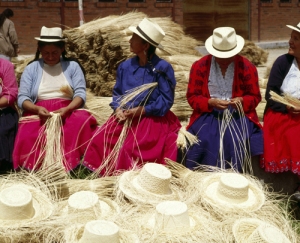
Women making Panama hats (in Ecuador)
Following that we went to the Museum Banco Central, which had a whole floor dedicated to the different regions and indigenous groups of Ecuador. There were plenty of models, pictures and artifacts to look at alongside information in Espanol. We decided we’d have an early dinner at a vegetarian restaurant and then continued on to a local brewery afterwards. We’d organised to meet Mark and Jennie in another bar but there was an Ecuadorian thrash band playing, five-dollar cover charge, and a room of sweaty Ecuadorians head banging, no thanks. We ended up in a bar called fly which stayed open past the 12am curfew for us in what turned into some sort of a lock in.
The next day Morgan, Britney and I dragged ourselves out to the Caja National Park despite feeling a little worse for wear. The weather wasn’t ideal, being heavily clouded over and a touch rainy, but it was still nice to get some mountain air and go for a walk out around the lake. At just under 4000m you could certainly feel the uphill climbs. There wasn’t a lot to see, despite being handed a massive bird watching chart upon entrance, and even the llamas ran away when we tried to take pictures with them. Later that afternoon I had lunch with the girls and then said goodbye as they headed to Peru.
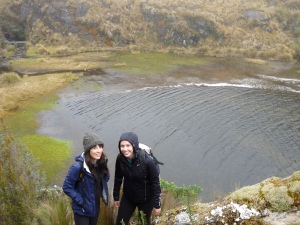
Morgan and Britney at Caja National Park
I met up with Jennie and Mark the next day as we were all travelling to Guayaquil prior to flying to the Galapagos Islands. Guayaquil is widely considered the most dangerous city in Ecuador so it was nice not to be arriving alone. Although the poverty on the outskirts was evident, there was a surprisingly pleasant, modern, strip along the waterfront. As we wandered along a 6 year-old kid drifted in behind us looking to snatch a wallet. Jennie gave him evil eyes but I wasn’t too concerned, getting anything out of skinny jeans is a tough task.
When I woke up the next morning, it was difficult to contain my excitement about going to The Galapagos. What should have been a routine flight turned out to be anything but. As we approached the runway on Baltra the plane didn’t quite land and we were informed we were returning to Gauyaquil. There was a collective sigh of disappointment from the passengers. I could almost smell the sea lions as we turned around.
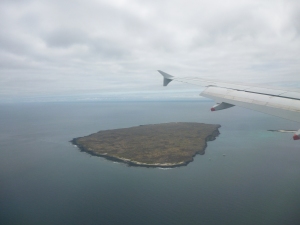
First sight of Galapagos
Fortunately, they put us up in a five star hotel, fed us and put us on another plane first thing the next morning. It also meant I met a few people including two great Israeli guys Omer and Michael, who I’d go on to spend quite a lot of time with. After saying I wasn’t going to book a cruise I got swept up in the excitement of the last minute deals and I booked an 8 day cruise. It meant changing my flights to spend an extra two days here, worse things have happened. Afterwards I met up with Mari, a great American girl who I would be couch surfing with for the week. That night we ate dinner in town and then played Ultimate Frisbee with some of her friends. If I’m honest I’ve always considered it a sport for those not talented enough to play a real sport but it was really good fun.
The next day I was straight into it booking a day trip to an island called Sante Fe, which was not included in the cruise ship itinerary. Although it was a long and bumpy boat trip to get there, the island itself was incredible. We docked the boat in the bay and landed in a dingy on a white sand beach filled with sea lions. Most were sleeping and none were concerned with our presence.
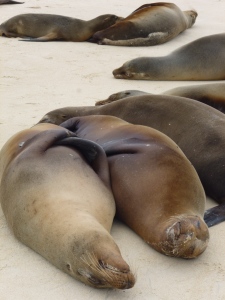
A couple of sleepy sea lions
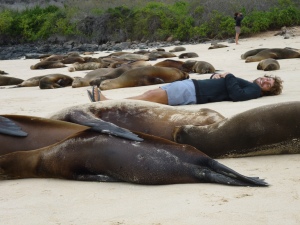
At one with / one of the Sea Lions
Afterwards we went for a walk up through the middle part of the island where we found some Galapagos doves and land Iguanas, a certain species only found on Isla Sante Fe. I caught him eating cactus and then licking his lips.
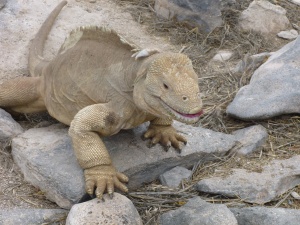
Up close and personal with a land Iguana
When we returned to the boat it was time for a snorkel so we hopped in the icy water for a look around. I was hoping for some sea lions to come play but instead found two massive turtles that were more than happy to be observed from close range. On the boat trip back to Santa Cruz we were treated to a dolphin show, with flipper and friends following our boat and jumping out of the water for about 20 minutes.
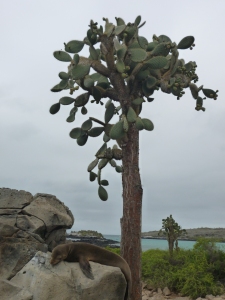
Sea lion next to a cactus, a unique sight
The following day I wanted to find some free activities; since arriving I had been hemorrhaging money. In the morning I went to Las Grietas, a canyon-like formation with crystal clear water. I went snorkeling there and it was really still and clear until a massive group of annoying American tourists turned up and started bombing off the rocks.

Natural canyon, Las Grietas
I got out of there as quickly as possible and headed for Bahia Tortuga, a stunning white-sand beach which is close to town. Initially the weather was pretty awful raining constantly but it eventually stopped and out of the mist came some massive black marine Iguanas and the famous blue-footed booby. The marine Iguanas eat sea algae and as an adaptation to excess salt consumption sneeze out salt through their nostrils. I’m not sure if it’s just coincidence but they seem to do it with increasing frequency as you approach them. The blue-footed booby definitely gets the prize for best named species. They are everywhere in the Galapagos and are easily distinguished via their blue feet (to state the obvious) and their hunting technique dive bombing for fish.
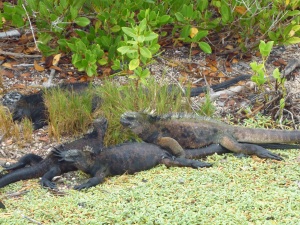
A couple of salt sneezing Marine Iguanas getting hot and heavy
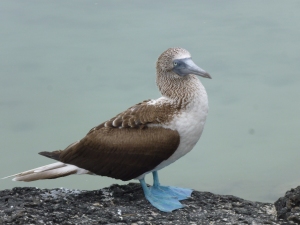
Blue-footed booby
I was sitting chilling out on the beach when Omer, Michael, and another Israeli girl Dor, came wandering down the beach. I wasn’t planning on staying but ended up spending the day on the beach with them. There were a bunch of tiny birds that came flocking in as soon as you got out food. I felt like some kind of a bird magnet, but also a bit like they were about to attack me.
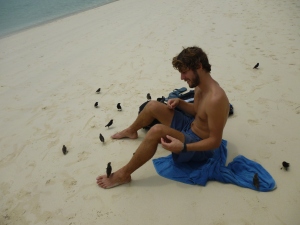
The Galapagos bird whisperer
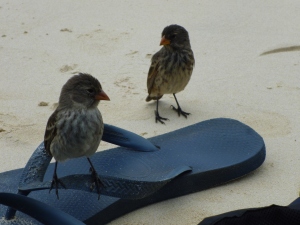
A bird in a thong (would only have a double meaning in Australia)
That night Mari and I met Jennie and Mark for dinner and then we all went and played ultimate frisbee with Mari’s group of friends. The following morning I headed on another solo mission to the Charles Darwin Centre, a ‘must visit’ in Puerto Ayora. I was pretty disappointed overall, especially with the visitors centre, which could be so much better. There were enclosures for the various giant tortoises from babies to those 100+ years of age and an empty pen where Lonesome George, the last giant tortoise of his species had lived until June this year. As they couldn’t fin a mate when he died his species became extinct, sad isn’t it?
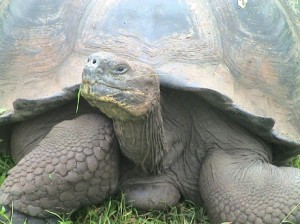
Galapagos Giant tortoise
Afterwards I met up with Omer, Michael, Dor and two other Israeli guys and the six of us headed out to Los Tuneles (underground lava tunnels). I don’t know if I’ve just been a tourist for too long and have lost my enthusiasm but they were not particularly interesting. However, Lilly, the Ecuadorian woman who worked at the entrance to the tunnels was a lot of fun. She invited us to pick oranges, make orange juice and hang out in her kitchen. Out of ideas that afternoon having ticked off everything I wanted to see in Santa Cruz I went for a run to Tortuga bay.
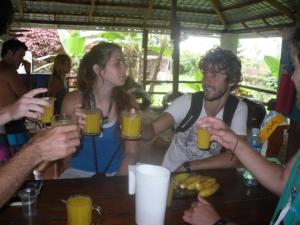
Orange juice at the lava tunnels with the Israelis
I had booked to go diving the next day, something I was extremely excited about, having heard that there is some of the best dives in the world here. Getting up at 5am to meet at the dive shop I arrived to the disappointing news there something was wrong with the boat. We couldn’t go to Isla Floreana but instead they could send us to Bartolame and Cousin Rock, north of Santa Cruz. I wouldn’t make it back in time for my ferry to Isabella so would have to delay a day. As it turned out we had two fantastic dives, which were quite different in terms of what we saw and the type of coral. The first dive at Bartolame was calmer, clearer and we saw turtles, manta ray, a Galapagos shark, white tip sharks and massive schools of fish (thousands of baracudas).
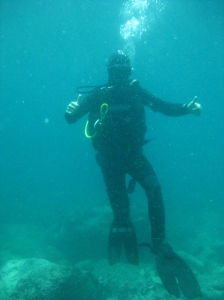
Diving in the Galapagos definitely gets a thumbs up
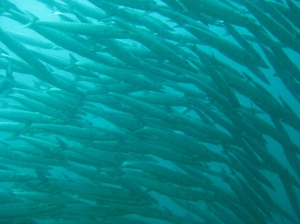
School of barracuda
The second dive was much more difficult as we battled strong currents. The visibility was worse but we saw a black tipped reef shark, two turtles right up close, an eel, a sea lion, and more massive schools of fish. Another amazing experience, I would have dived more if it wasn’t $150 a day.
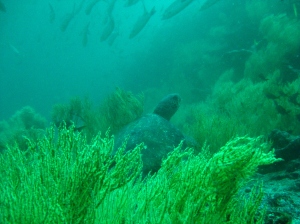
Turtles everywhere
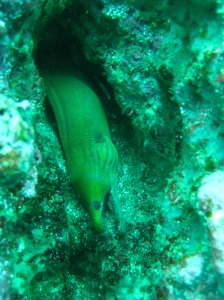
Eels up inside
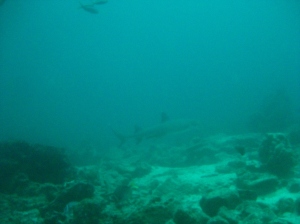
Shark!
We returned to Santa Cruz and I had missed my ferry to Isabella, so I spent another night at Mari’s house. She made pesto pasta which we ate together and shared a beer. She was a great couch surfing host sharing her knowledge of the Galapagos and taking me to frisbee. Plus she had a spare room so I didn’t have to sleep on the couch. The next morning I headed off early for Isabella. This is considered the prettiest of the islands that are inhabited with plenty of cheap/free activities for the day. I met Mark and Jennie and Mark and I went down to the beach to read and get some sun. After lunch I walked out to one of the Giant Tortoise sanctuaries nearby to have a look around. On the way were some pink flamingoes, cool to see. That night we went for a run and then had dinner and drinks on the beach.
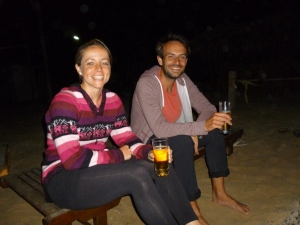
Drinks on the beach in Isabella with Mark and Jennie
The next morning we went on a snorkelling tour to las tonteras (white tip sharks). There is a small channel of water where the white tipped reef sharks ‘sleep’ during the day. We also wondered around the island looking at hundreds more black marine iguanas basking in the sun. Afterwards we went snorkelling in a bay that was full of turtles, but nothing else. There was some kind of a turtle party going on with about 15 turtles hanging out in one area. I opted to go without a wetsuit so only lasted about 30 minutes in the cold water. Omer and Michael arrived that afternoon and we hung out in hamacs watching BBC documentaries on the Galapagos. Interesting fact, the name ‘booby’ is derived from the Spanish word bobo, meaning fool.
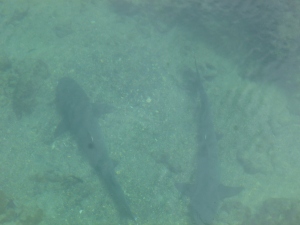
White tipped reef sharks
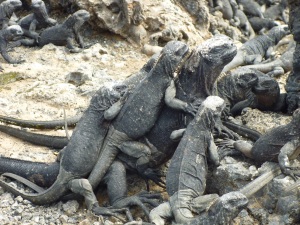
Pile of salt iguanas
We said bye to Mark and Jennie and Omer, Michael and I attempted to go to Volcan Sierra Negra without a guide. The key word being attempted, we got lost and couldn’t find it. Unlike other treks, where a guide comes recommended but you don’t really need one, this time we needed one. We’re unsure where we went wrong but we ended up wandering through Galapagos forest for a few hours failing to find a crater. Although disappointing not to find the volcano we did fid a small rat, which we believe (based on nothing) is a new species not yet discovered here. We have named it the ‘Gris Austrael’, a combination of our countries.
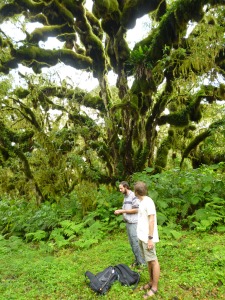
Does google maps work out here?
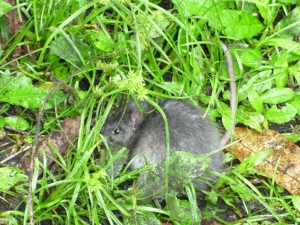
New species found, the Gris Astrael
Once we found civilisation again, we we asked for help and ended up visiting a cave nearby. It was much better than the lava tunnel in Santa Cruz. Afterwards we walked back to Esperanza where we stumbled upon a group of Anthropology students from Miami being educated and entertained by a local couple. They had a finca where they grew coffee and we sampled and then bought some of the produce. We hung around while they had a question and answer session with the weird American teacher then got the bus back to Puerto Villamil. That ended the self-guided tour, with Tuesday the first of eight days on a boat as part of the budget-blowing all inclusive.
The first morning of the cruise we were waiting around at the airport for the rest of the group to arrive. By chance I bumped into Bruno and Marjolein so we had a coffee and caught up on what had been happening since leaving Santa Marta. First activity on the boat was lunch and then we took the dinghys over to Barchas beach on the uninhabited side of Santa Cruz. The highlight was a brackish lake with pink flamingos and marine iguanas.
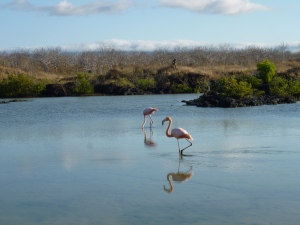
Pink flamingos at Barchas beach, Santa Cruz
Overnight we moved to Genovesa Island in the north of the archipelago. We went for a walk in the morning to see birds, a lot of birds. There were Red-footed boobies, Nazca boobies, Frigate birds, Swallow-tailed gull, Brown pelicans, Galapagos doves and Mockingbirds. There were nests and chicks everywhere.
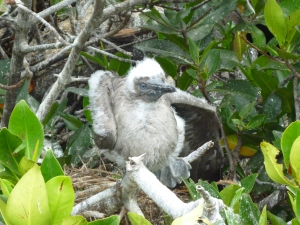
Crazy-faced baby booby
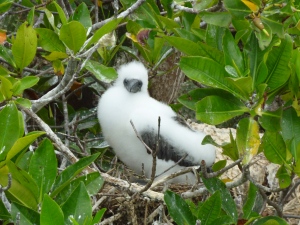
Frigate bird chick/a comfortable pillow
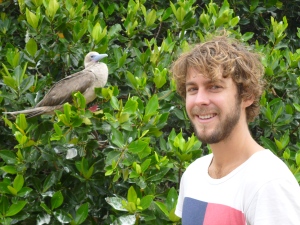
Red footed booby
In the afternoon we went for a dingy trip to view fur seals and herons. The fur sea lions are timid because they were hunted in the past and can only be seen on the more remote islands. Afterwards we went for a walk up Prince Phillip’s stairs to look at the breeding ground of the Nazca (masked) boobies. Michael, Omer and I watched a documentary on The Galapagos and decided they are the evil boobies. The parents lay two eggs but one sibling, usually the one that hatches first, pushes the other sibling out of the nest so it dies. Galapagos must be one of the few places you can say there are boobies everywhere and not be met with judging eyes.
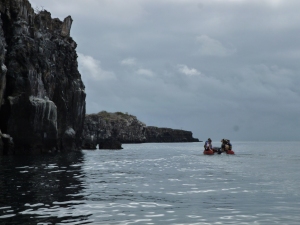
Dinghy ride to Prince Phillip’s stairs, Genovesa
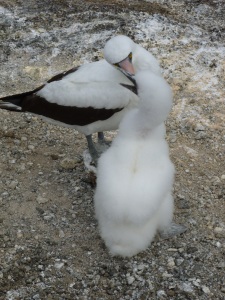
Mother booby feeding a baby booby
The other main objective of the walk was to try and site the short-eared owl. On Genovesa Island it is the main predator and, somewhat unusually, hunts by day. We’d all but given up finding it until all of a sudden it appeared out of nowhere and started circling looking for prey. That night I had a great chat in Spanish with Christina, from Valencia, about all things Spain. Nice to get some practice in leading up to my pending Spanish exam in November, more on that later.
We moved early morning from Genovesa to Marchena. This is an island not many boats get to visit. You’re not allowed to walk on it so we had two snorkeling trips for the day. The first in the morning was at Punta Mejia. It was fairly open and exposed to the rough seas and there wasn’t much to see. Actually that’s generous there was nothing to see; everyone returned pretty disappointed with multiple people vomiting from motion sickness.
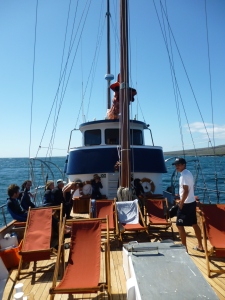
The deck of our sail boat, The Samba
Luckily the afternoon session made up for it. We snorkeled in a protected pool with sea lions. The babies came to play and the water was warm so it was happy days. That night we started our navigation to Isabella and it was extremely rough conditions the entire way. There was food flying everywhere as we attempted to eat dinner on the move.
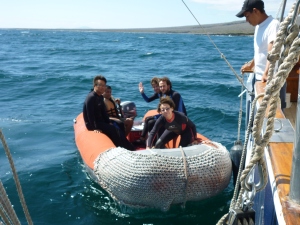
Snorkelling from the ‘Panga’
One of the busiest days of the trip started at 530am with a dinghy ride to see the flightless cormorants. They are only found here in the Galapagos and use their slightly deformed looking wings for swimming rather than flying. Mid morning we took a walk for two hours to see what was left of an old American Naval Base from WWII. There were plenty more large marine iguanas and we saw the flightless cormorants up close.
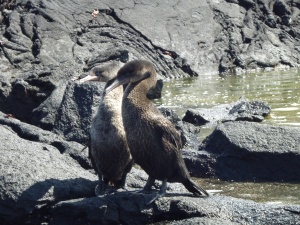
Flightless Cormorants
We moved location for the afternoon snorkel (passing over the Equator and celebrating with cocktails) in what was to be the best of the trip. There were hundreds of sea turtles but it was the sea lions and penguins that stole the show. The sea lions played around swimming right up to your face and it was incredible to watch penguins hunting fish underwater. I also saw cormorants and stingrays.
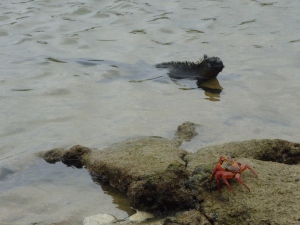
Crab and a marine iguana
We celebrated another enjoyable day with a few rums on the deck and several games of Kabul. The two dining tables had been more or less established by this point, with one table affectionately known as the ‘frigate birds’.
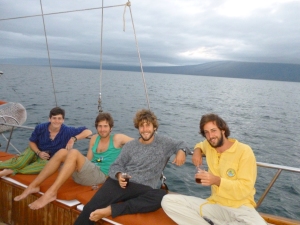
Rums on the deck with PJ, Omer and Michael
We were up early for a walk on Floreana, which is the newest Volcano in the archipelago. Walking across the lava field was interesting as we observed hundreds more marine iguanas and the odd sea lion doing its thing. There was also plenty of dead animals, some interesting cacti, and a whale skeleton to look at.
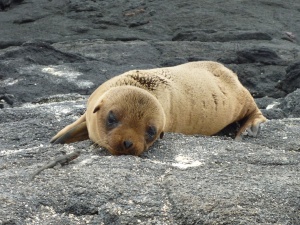
Baby sea lion
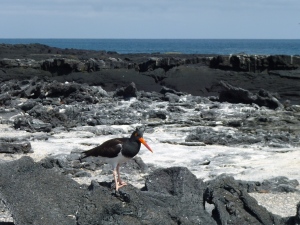
Oyster catcher
Afterwards we went snorkeling in a ‘hot spot’ to observe marine iguanas feeding on algae. The term hot spot could not be further from the truth when it came to the water temperature, it was the sort of cold that makes your boy hurt. The visibility was poor but we saw a few iguanas freezing for the sake of a feed. That afternoon we were back on land thawing out and observing giant tortoises and land iguanas.
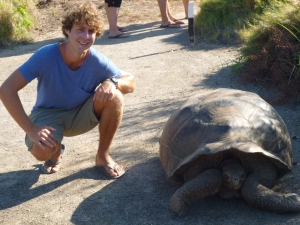
Baby face clean shaven alongside wrinkly face ancient giant tortoise
Sunday was our final day on Isabella. The morning trip was a 6am boat ride to mangroves at Elizabeth Bay. We floated about in the calm shallows watching turtles, sea lions and penguins. We also saw a Galapagos Hawk perched hire on a tree. Although more or less the same animals it was a great trip and the highlight of the day.
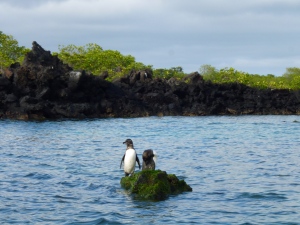
Penguins
The snorkeling trip was a bit further south with the hope being to spot eels or sea snakes in the algae. Again the water temperature felt sub zero and the visibility was terrible if you strayed from the shallows. I did see turtles (standard) and a few fish I hadn’t seen but certainly couldn’t find the eels. The afternoon land trip was a walk across a lava field. Luckily we had a beautiful day and so had full views of Sierra Negra, the volcano that Omer, Michael and I had unsuccessfully tried to trek to a week earlier. There were more pink flamingos in one of the lakes and a heap of white tipped reef sharks trapped in another close to the ocean. That night was a pretty horrid 13-hour navigation in our little Samba boat but luckily I don’t suffer from motion sickness.
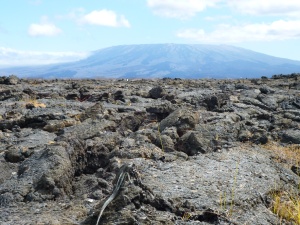
Lava lizard taking in the view on the lava field
The overnight navigation was to get us down to Floreana, an island in the south. It was another buffet breakfast before a day looking around a tortoise reserve and hearing about the human history on the island. There was an ongoing joke in the group about staying 2 metres from the animals and not touching them. A funny German man, Manfred, loved quoting Martha, the guide, throughout the trip about all the rules. My roommate Joon, from Korea, chose to ignore most of them constantly getting in the animals’ faces.
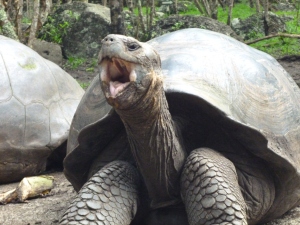
Rahhh
We navigated back to Santa Cruz that afternoon and had a farewell cocktail with the crew that night before disembarking in Puerto Ayora for a couple of hours. I picked up a nice and touristy booby singlet to take away. We finished off the last night with red wine and rum over a casual game of South African style kings led by PJ. The last morning we headed to yet another giant tortoise farm, just to make sure we were turtled out. We also went to Las Gamelas, a couple of volcanic craters on the way to the airport. We had a great mix of people, fantastic guide and crew, and an unforgettable experience in the Galapagos. This was undoubtedly one of the highlights of my trip.
Tags: Bahia Tortuga, Cuenca, Diving, Galapagos, Guayaquil, Isabella, Las Grietas, Las Tonteras, Los Tuneles, Panama Hat, Parque Cajas, Puerto Ayora, Santa Cruz, Sante Fe, Sea Lion, Shark, Sierra Negra
